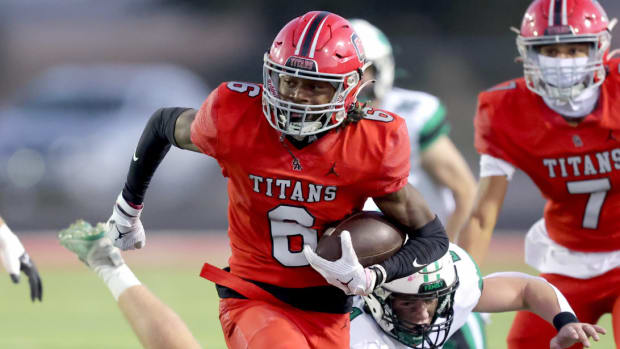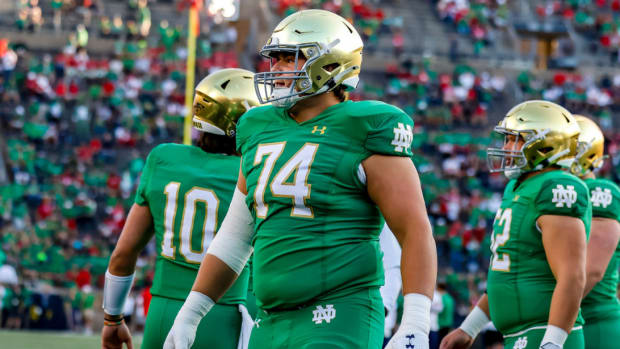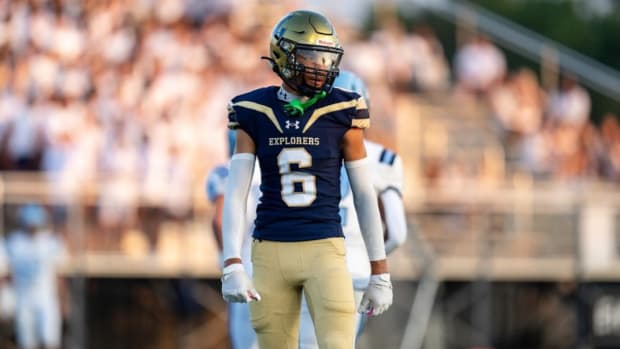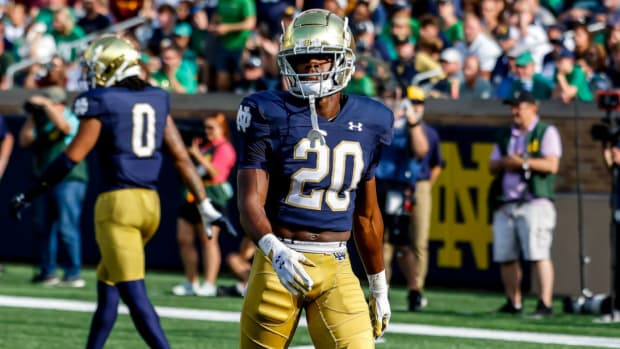Key Takeaways From The Notre Dame Win Over South Florida: Offense
Notre Dame controlled the action against South Florida from the get-go, and it ended with a convincing 52-0 victory to improve the Fighting Irish to 2-0.
There were several things to be learned about the offense from the win. There were some steps in a good direction, and there are some questions that remain coming out of it.
Let’s look at the key takeaways from the win.
OFFENSIVE LINE TOOK A BIG STEP
I wrote in my keys to victory that I didn’t care how many yards the offense rushed for against South Florida. The offensive line is talented enough, and South Florida is bad enough, that Notre Dame could pile up a bunch of rushing yards and not really make any improvement, at least not the kind of improvement you need to beat the likes of Clemson. We’ve seen that in the past, but that was not the case against South Florida.
While some might focus on the 281 rushing yards, the 6.2 yards per carry or the six touchdowns, the big key for me was how the offensive line played. That’s what I wrote about before the game, I cared more about HOW they ran the ball than I did about the how much.
Notre Dame’s offensive line, for the most part, was quite physical at the point of attack and got impressive movement against the Bulls. We saw the line come off with a vertical push, we saw them drive South Florida defenders backwards and we saw them open up some pretty big run lanes. Even on some of the outside zone plays, which is a run concept not necessarily designed to get a vertical push, we saw them get a bit of a vertical push at times.
We saw the line play with force, physicality and we saw them finish at a high level. If this is the kind of performance we see week after week (and again, I’m talking about style, not results) this line will have every opportunity to live up to its billing as the nation’s top offensive line. It certainly played like it against South Florida.
THE TIGHT END GROUP IS LEGIT
Excellent tight end play is the norm at Notre Dame, and after two weeks it’s obvious that will continue in 2020. Junior tight end Tommy Tremble had arguably the best game of his career against USF, hauling in a career-high 61 receiving yards and dominating as a blocker, but he wasn’t alone.
Senior Brock Wright had his most effective blocking game in four years, and talented freshmen Michael Mayer was also effective in the run game. The number of teams that would have a guy like George Takacs as the fourth string tight end can be counted on one hand.
We’ve seen this unit make plays in the pass game and we’ve seen them dominate in the run game. It was Mayer who made the impressive pass catching plays against Duke, but it was Tremble that showed off borderline wide receiver skills against South Florida. He outran the defense on an early out cut and made a highlight real sideline grab for a 27-yard gain later in the contest.
If the tight ends carry what we saw against USF into future games it will force defenses to spend a lot of time focusing on them and less time focusing on the running backs and wide receivers.
RUNNING BACK DEPTH CHART IS MUCH BETTER THAN EXPECTED
I’m not reacting to the yards the backs racked up, because the truth is I don’t care about the yards a team or a player puts up against an opponent like South Florida. In these types of games I care more about how they play, meaning how do they perform in areas that do in fact translate from opponent to opponent, and that is what impressed me about the Irish running back performance.
For example, in the opener against Duke the backs struggled in pass protection, but late in the game Kyren Williams stepped up and made a crucial block. That shows progress, and the unit as a whole improved in game two against South Florida. That’s the kind of positive step you want to see, because knowing who to block is more about you than it is about the quality of the opponent, same with the effort, and the Irish backs graded out well in both areas.
It’s not the 254 rushing yards or 8.2 yards per carry that Williams, Chris Tyree and C’Bo Flemister combined for either, although it was impressive. The unit showed growth, it showed patience, and it showed the ability to make people miss both with cuts and by running with authority.
Williams showed improvement from a decision making standpoint in his second start, and our first chance to see Flemister showed a back with more patience and elusiveness than we saw last season. Flemister really stood out with his reads, and it resulted in him hitting holes with far greater timing than we saw in 2019. Tyree also impressed with his physical running style, which is important when you consider that what he is known for is speed.
If the backs continue this level of growth not only will the position group not be a question mark anymore, it will become a strength.
WIDE RECEIVERS MUST GET BETTER … BY A LOT
If I’m being consistent, I can’t say the fact the Irish wide receivers caught just four passes in the victory is what bothers me. Did it kind of bother me? Yes, but when you dominate on the ground and you have the tight ends Notre Dame has this will happen at times. What really bothered me is how the wide receivers played, and the fact the coaching staff seems to have made very little effort to get them involved outside of the first couple of series.
Senior Javon McKinley was once again rarely looked at in the pass game, and on one of the downfield targets he was missed by the quarterback, badly. A back shoulder attempt to him was off target and carried him out of bounds, but he didn’t help matters much with a route that got him so close to the sideline. McKinley is not showing the get off and burst he did last season when he caught fire, and the Irish staff needs him to play with a greater sense of urgency as a route runner.
It was the first game back for junior Braden Lenzy, so I’m not going to make too much of his performance, but he didn’t show the separation he is capable of either. His routes looked telegraphed, which honestly is often a by-product of a receiver coming back from a leg injury. Notre Dame needs more from him than we saw on Saturday.
After making plays against South Florida, Joe Wilkins Jr. was nothing but an afterthought in the game plan, and the Irish didn’t play the talented freshmen (Xavier Watts, Jordan Johnson) until the game was out of hand. Not only did we not see progress from the receivers, we saw regression, and the questions that I had entering the season have grown.
BOOK IS STILL A WORK IN PROGRESS
There were things I liked from quarterback Ian Book on Saturday. I thought his feet were more calm in the pocket, I thought he was more willing to keep his eyes downfield as he worked through his progressions, and the timing with which he went to his check downs was appropriate and effective. His first touchdown run was a great example, as he moved outside, worked to the perimeter but kept his eyes downfield until the moment he decided to take off … that was progress.
The issue, however, is that Book is showing a clear lack of confidence in some of the players around him. No, he doesn’t have Chase Claypool or Miles Boykin anymore, but it’s up to him, as a captain, as a veteran, as a leader, to build up those newcomers to the “spotlight” role at wide receiver. Book needs to give them chances to make plays, and lift them up and bring them along.
We didn’t see that against USF. The lack of separation by the receivers is an issue, but there were enough throws that could and should have been made by Book to give them a chance to make the plays. A lack of separation shouldn’t equal no throws, at least not with a quarterback with Book’s ability and reputation. The pass catchers can’t prove themselves in those one-on-one situations if they don’t get the opportunities, and he won’t grow more confidence in them if they don’t prove themselves.
Book still needs to be more assertive attacking down the field as well.
There’s also the issue of his sudden inconsistency on throws he used to make with ease in the past, the so-called “lay ups” that Brian Kelly refers to. The miss to McKinley on an in cut that should have been an easy pickup for the Irish was concerning. His late read and lack of accuracy on the corner route in the end zone to Wilkins (that should have been a touchdown) was equally problematic.
Getting Book on track in the next week against Wake Forest and then getting some things figured out during the bye week is a must, because the reality is while Notre Dame is good enough to beat Duke and South Florida without Book playing well, they will absolutely need him at his best to win most of their October and November games.
———————
Become a premium Irish Breakdown member, which grants you access to all of our premium content, our premium message board and gets you a FREE subscription to Sports Illustrated! Click on the link below for more
Be sure to stay locked into Irish Breakdown all the time!
Join the Irish Breakdown community!
Subscribe to the Irish Breakdown podcast on iTunes.
Follow me on Twitter: @CoachD178
Follow me on Parler: @BryanDriskell
Like and follow Irish Breakdown on Facebook




